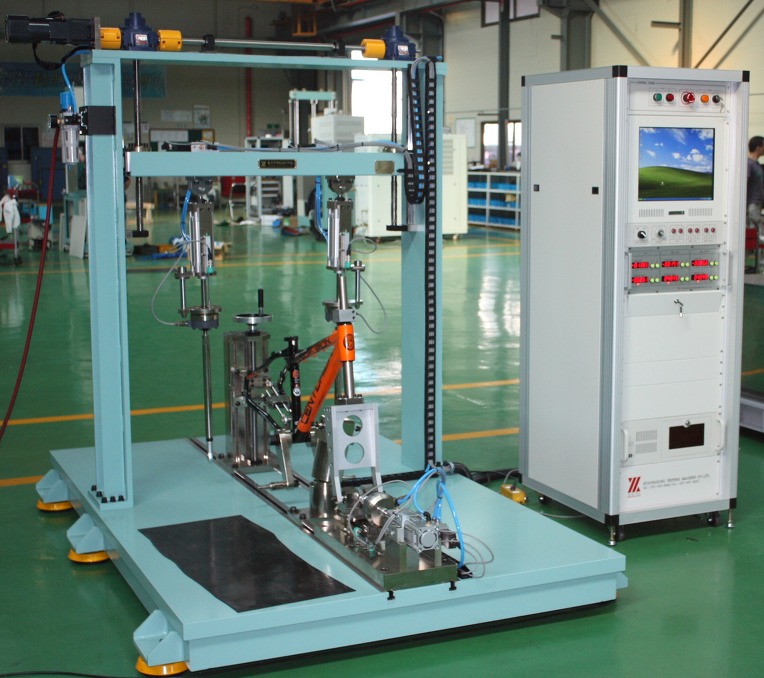 |
COMPUTER TYPE DYNAMIC FATIGUE TEST
(Two Pneumatic Cylinder)
This tester is suitable to test bike’s parts & materials and integrated dynamic fatigue state, the test functions are sufficient, and applications are wide, compliant to the bike test standards applied in numerous countries.*In accordance with
EN14764, EN14765, EN14766, EN14781 ISO 7500/1, EN 1002-2, BS 1610, DIN 5122, ASTME4, JIS B7721/B7733, CNS 9471/9470, JJG 475-88 |
Machine Mechanism:
1. Capacity: 5000N
2. Test Space: 0~800mm
3. Test Stroke: 0~100mm
4. Test Frequency: 3Hz
5. Automatic Stop: when Specimen is broken
6. Servo Hydraulic Actuator
Force Sensor:
1. Load cell: 500kg.
2. Dynamic loading system.
3. Output voltage 2MV.
4. With break device.
Displacement Sensor:
1. LVDT displacement sensor.
2. Test range: 0 – 100mm.
3. Repeatability test: within 0.05mm.
4. Accuracy: 0.5%
Hydraulic power:
1. Hydraulic overload prevention device.
PC software:
1. Data acquisition and data analysis.
2. Constant load and constant stroke control.
3. Auto waves: sine wave, square wave and triangle wave.
4. Close loop control system.
5. Curve and information display.
6. Data save.
7. Curve display, time vs. force, Displacement vs. force.
8. Testing report print.
Test Grips: One sets of grips (according to customers’ requirement).
- Pentium COMPUTER

Frame - Fatigue test with pedalling forces
General
All types of frame shall be subjected to this test. In tests on suspension frames with pivoted joints, adjust the spring, air-pressure, or damper to provide maximum resistance, or, for a pneumatic damper in which the air-pressure cannot be adjusted, replace the suspension-unit with a rigid link, ensuring that its end fixings and lateral rigidity accurately simulate those of the original unit. For suspension-frames in which the chain-stays do not have pivots but rely on flexing, ensure that any dampers are set to provide the minimum resistance in order to ensure adequate testing of the frame.
Where a suspension frame has adjustable brackets or linkages to vary the resistance of the bicycle against the ground-contact forces or to vary the attitude of the bicycle, arrange the positions of these adjustable components to ensure maximum forces in the frame.
Test method
NOTE If a genuine fork is used, failures of the fork are possible, therefore, it is recommended that for convenience, a dummy fork stiffer and stronger than the genuine fork is used.
Where a frame is convertible for male and female riders by the removal of a bar, test it with the bar removed.
Mount the frame assembly on a base with the fork or dummy fork secured by its axle to a rigid mount of height Rw(the radius of the wheel/tyre assembly ± 30 mm) and with the hub free to swivel on the axle. Secure the rear drop-outs by means of the axle to a stiff, vertical link of the same height as that of the front, rigid mount, the upper connection of the link being free to swivel about the axis of the axle but providing rigidity in a lateral plane, and the lower end of the link being fitted with a ball-joint. Fit a crank, chain-wheel and chain assembly or, preferably, a strong, stiff, replacement assembly to the bottombracket and described in a) or b) below.
a) If a crank/chain-wheel assembly is used, incline both cranks forwards and downwards at an angle of 45° (accurate to ± 0,5°) to the horizontal and secure the front end of the chain to the middle chain-wheel of three, the smaller chain-wheel of two, or the only chain-wheel. Attach the rear end of the chain to the rear axle and perpendicular to the axis of the axle.
b) If an adaptor assembly is used (as shown in Figure 29), ensure that the assembly is free to swivel about the axis of the bottom-bracket and that both replacement arms are 175 mm long(L) and that they are both inclined forwards and downwards at an angle of 45° (accurate ± 0,5 °) to the horizontal. Secure the position of the crank replacement arms by a vertical arm (which replaces the chain-wheel) and a tie-rod which has ball-joints at both ends and which is attached to the rear axle perpendicular to the axis of the rear axle. The length of the vertical arm(Rc) shall be 75 mm and the axis of the tie-rod shall be parallel to and 50 mm from the vertical plane through the centre-line of the frame. Subject each pedal-spindle (or equivalent adaptor component) to a repeated downward force of 1 000 N at a position 150 mm from the centre-line of the frame in a vertical, transverse plane and inclined at 7,5° (accurate to within ± 0,5°) to the fore/aft plane of the frame. During application of these test forces, ensure that the force on a "pedal-spindle" falls to 5 % or less of the peak force before commencing application of the test force to the other "pedal-spindle". ply the test forces for 100 000 test cycles where one test cycle consists of the application and removal of the two test forces.